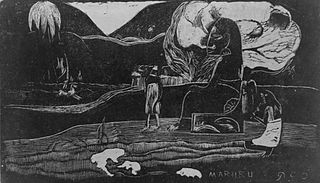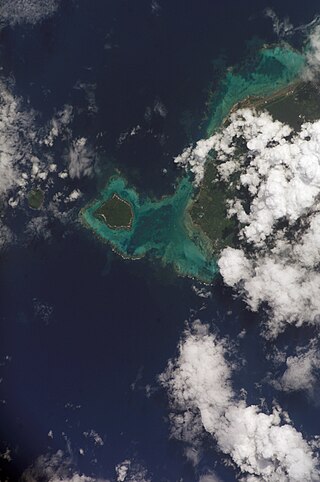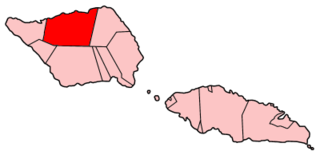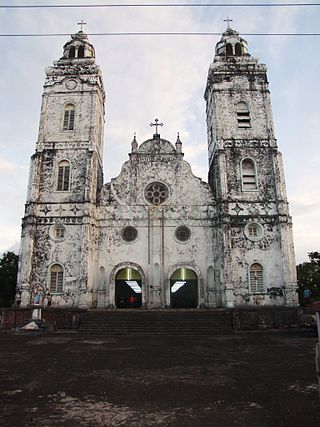
Hina is the name assigned to a number of Polynesian deities. The name Hina usually relates to a powerful female force who has dominion over a specific entity. Some variations of the name Hina include Sina, Hanaiakamalama, and Ina. Even within a single culture, Hina could refer to multiple goddesses and the distinction between the different identities are not always clear. In Hawaiian mythology, the name is usually paired with words which explain or identify the goddess and her power such as Hina-puku-iʻa (Hina-gathering-seafood) the goddess of fishermen, and Hina-ʻopu-hala-koʻa who gave birth to all reef life.
Samoan culture tells stories of many different deities. There were deities of the forest, the seas, rain, harvest, villages, and war. There were two types of deities, atua, who had non-human origins, and aitu, who were of human origin.

Savaiʻi is the largest and highest island both in Samoa and in the Samoan Islands chain. The island is also the sixth largest in Polynesia, behind the three main islands of New Zealand and the Hawaiian Islands of Hawaii and Maui.
The Alofaaga Blowholes, also known as the Taga Blowholes, are a natural feature located in the district of Palauli, south west of Salelologa wharf on the island of Savai'i in Samoa. The entrance to the blowholes is in the village of Taga.

Samoa is made up of eleven itūmālō. These are the traditional eleven districts that were established well before European arrival. Each district has its own constitutional foundation (faavae) based on the traditional order of title precedence found in each district's faalupega.

Aiga-i-le-Tai is a district of Samoa which includes the small islands of Manono, Apolima and tiny uninhabited Nu'ulopa lying in the Apolima Strait between the country's two main islands of Upolu and Savai'i.

Gagaʻemauga is a district on the island of Savaiʻi in Samoa. The district is situated on the central north side of Savaiʻi. The name 'Gagaʻemauga' literally means "near side of the mountain", meaning the eastern side of the mountain chain running through the centre of Savaiʻi Island.

Gagaʻifomauga is a political district on the island of Savaiʻi in Samoa. The district is situated on the northern side of the island with a population of 4,878.

Safune is a traditional village district on the central north coast of Savai'i island in Samoa. It lies within the electoral constituency of Gaga'ifomauga. Safune is the birthplace of Mau leader Olaf Frederick Nelson and the filming location of Moana, one of the first documentaries made in the world. The Mata o le Alelo pool associated with the Sina and the Eel Polynesian legend is also in Safune.

Fa'amatai is the indigenous political ('chiefly') system of Samoa, central to the organization of Samoan society. It is the traditional indigenous form of governance in both Samoas, comprising American Samoa and the Independent State of Samoa. The term comprises the prefix fa'a and the word matai.

Fāgogo is a word in the Samoan language to describe a type of storytelling of the Samoa Islands. It is called "a performing art, almost a type of theatre, where people, events and stories are brought to life through the skills, voice and action of a narrator". There are several collections of Samoan fāgogo, the most notable being those collected by Augustin Kramer, Brother Herman, and Richard M. Moyle.

Sale'aula is a village on the central north coast of Savai'i island in Samoa and is the traditional center of the Gaga'emauga political district. Chief council meetings are held at Vaitu’utu’u malae in the village. The village has a population of 600. Sale'aula is one of two main pules in samoa, the other consisting of safotulafai. Sale'aula is one of the two highest villaes in the whole samoa. Hence why they're called a pule village.

Fagamalo is a village situated on the central north coast of Savai'i in Samoa. It is a sub-village or pito nu'u of the larger traditional village enclave of Matautu in the political district of Gaga'emauga. The population of the village is 383.

Fagaloa is located on the north eastern coast of Upolu island in Samoa. The area is a significant region of conservation and culture. The bay is situated within the political district of Va'a-o-Fonoti and is ruled by the Ulualofaiga Talamaivao, descendants of the first Ulualofaiga, son of the King of Tonga, Tui Toga Faisautele

Sina and the Eel is a myth of origins in Samoan mythology, which explains the origins of the first coconut tree.

Safotu is a village on the central north coast of Savai'i island in Samoa. Safotu is in the district Gagaifomauga and has a population of 1270. Traditionally, it attained the status of 'Pule,' customary political authority, and has been the main centre of the Gagaifomauga district.

Archaeology of Samoa began with the first systematic survey of archaeological remains on Savai'i island by Jack Golson in 1957. Since then, surveys and studies in the rest of Samoa have uncovered major findings of settlements, stone and earth mounds including star mounds, Lapita pottery remains and pre-historic artifacts.
Samoan proverbs form an important part of the traditions and culture of Samoa where oratory, poetry, metaphors and subtlety in language art forms are held in high esteem as a form of communication in ceremony and ritual of fa'a Samoa. The importance of oratory is reflected in Samoa's indigenous chiefly system, fa'a Matai, where titleholders are either ali'i or orator (tulafale) status.

The Falemauga Caves are large natural caverns in a series of lava-tunnels situated in the Tuamasaga district along the central ridge of Upolu island in Samoa. The caves have been studied by archaeologists in Samoa with evidence of human occupation in pre-history. They were also used as a place of refuge by the people of Tuamasaga.
Piula Cave Pool is a natural freshwater pool by the sea beneath the historic Methodist Chapel at Piula on the north coast of Upolu island in Samoa. It is situated at Lufilufi in the political district of Atua, 26 km east from the capital Apia, along the scenic coastal road. Entry is by the main road through the painted stone wall of Piula Theological College with steps leading down to the pool.

















